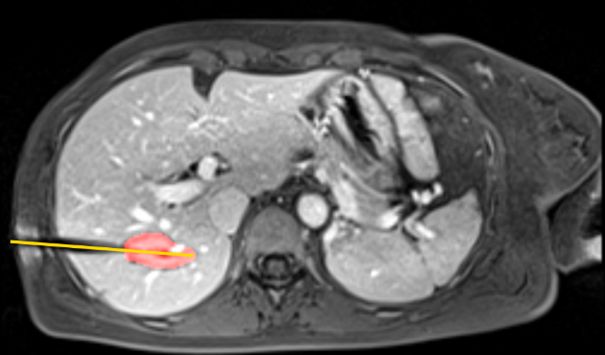NEWS
Studierende veröffentlichen Forschungsergebnisse zur Simulation von Mikrowellenablation bei Lebertumoren
Ein interdisziplinäres Forschungsteam des Forschungscampus STIMULATE hat im renommierten Journal of Clinical Medicine eine wegweisende Studie zur Simulation von Mikrowellenablation (MWA) bei der Behandlung von Lebertumoren veröffentlicht. MWA ist eine führende, minimal-invasive Methode zur gezielten Tumorzerstörung, bei der Tumorgewebe durch Hitze zerstört wird. Die Studie, die im Rahmen des MSE Research Tracks durchgeführt wurde, zeigt eindrucksvoll, wie Studierende bereits während ihres Studiums an der vordersten Forschungsfront mitwirken, neue Forschungsergebnisse erzielen und diese als Erstautorenpublikationen in hochrangigen Journalen erreichen können. Die Forschungsergebnisse demonstrieren, wie Simulationen den Therapieprozess verbessern und neue Ansätze zur Entwicklung von Ablationsgeräten unterstützen.
Im Rahmen der Studie wurde in interdisziplinärer Zusammenarbeit der STIMULATE-Forschungsgruppen iMRI (tech & clin), Image Processing und Medical Flows eine MWA-Nadel modelliert und deren Wirksamkeit in einem sogenannten Polyacrylamid-Phantom und an einem klinischen Fall getestet. Die Simulationen zeigten eine hohe Übereinstimmung mit den experimentell erfassten Temperaturverläufen. Zur Bewertung der Zerstörung des Tumorgewebes wurden zwei Modelle genutzt: das Arrhenius-Schadensmodell und ein kritisches Temperaturmodell. Insbesondere das Arrhenius-Modell wies eine moderate Übereinstimmung mit den Ergebnissen aus den klinischen Fällen auf und hob potenzielle Verbesserungsmöglichkeiten für die Simulation und die Geräteentwicklung hervor. Trotz der vereinfachten 2D-Simulation konnten die Forschenden realistische Ablationsmuster erzeugen, die eine Grundlage für die zukünftige klinische Anwendung bilden könnten.
Besonders bemerkenswert ist, dass diese Arbeit ein weiterer Beleg für die erfolgreiche Kombination von experimentellen Ansätzen und numerischer Simulation innerhalb der medizinischen Technik ist. Die Forschungsgruppe konnte zeigen, dass durch den Einsatz moderner Bildgebung und Simulationstools die Behandlungsergebnisse bei Lebertumoren verbessert werden können. Die Ergebnisse haben das Potenzial, die Ablationsverfahren in der klinischen Praxis effizienter und genauer zu machen und bieten wertvolle Ansätze für die Weiterentwicklung der MWA-Technologie.
Der Forschungscampus STIMULATE gratuliert den Studierenden und dem Forschungsteam herzlich zu ihrer erfolgreichen Veröffentlichung und würdigt damit ihre herausragenden Leistungen und ihren Beitrag zur Weiterentwicklung der Medizintechnik.
Students publish research results on the simulation of microwave ablation for liver tumours
An interdisciplinary research team from the Research Campus STIMULATE has published a pioneering study in the renowned Journal of Clinical Medicine a ground-breaking study on the simulation of microwave ablation (MWA) in the treatment of liver tumours. MWA is a leading, minimally invasive method for targeted tumour destruction in which tumour tissue is destroyed by heat. The study, which was carried out as part of the MSE Research Track, impressively demonstrates how students can be involved at the forefront of research during their studies, achieve new research results and have them published as first-author publications in high-ranking journals. The research results demonstrate how simulations improve the therapy process and support new approaches to the development of ablation devices.
As part of the study, an MWA needle was modelled in an interdisciplinary collaboration between the STIMULATE research groups iMRI (tech & clin), Image Processing and Medical Flows and its effectiveness tested in a polyacrylamide phantom and on a clinical case. The simulations showed a high degree of agreement with the experimentally recorded temperature curves. Two models were used to evaluate the destruction of the tumour tissue: the Arrhenius damage model and a critical temperature model. In particular, the Arrhenius model showed moderate agreement with the results from the clinical cases and highlighted potential improvement opportunities for simulation and device development. Despite the simplified 2D simulation, the researchers were able to generate realistic ablation patterns that could form a basis for future clinical application.
It is particularly noteworthy that this work is further evidence of the successful combination of experimental approaches and numerical simulation within medical technology. The research group was able to show that the use of modern imaging and simulation tools can improve treatment outcomes for liver tumours. The results have the potential to make ablation procedures more efficient and accurate in clinical practice and offer valuable approaches for the further development of MWA technology.
The Research Campus STIMULATE congratulates the students and the research team on their successful publication and recognises their outstanding achievements and their contribution to the further development of medical technology.
